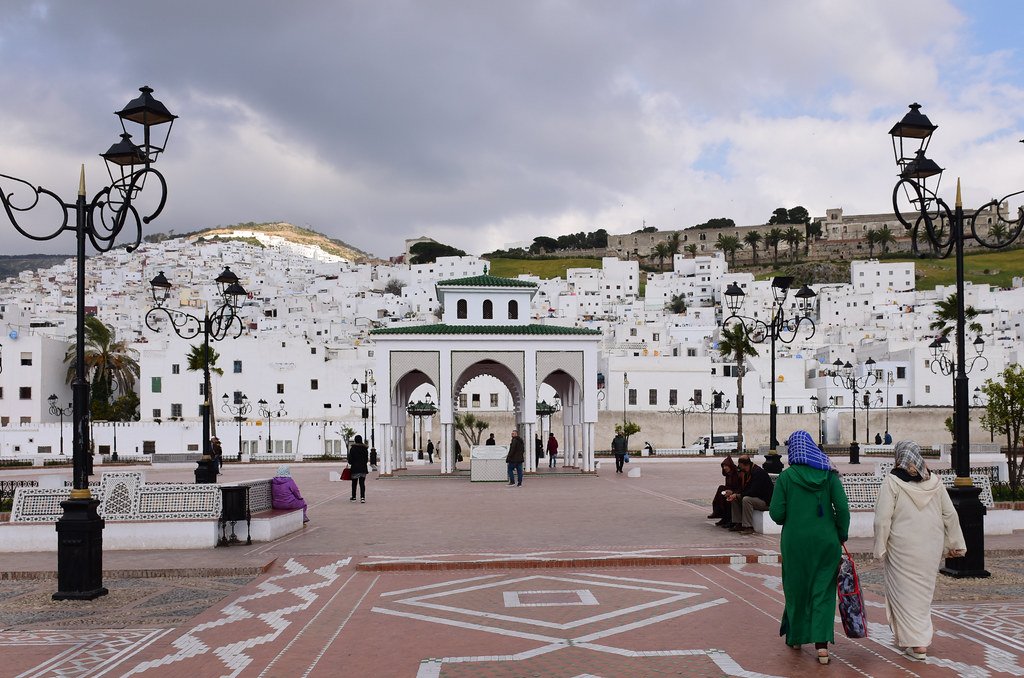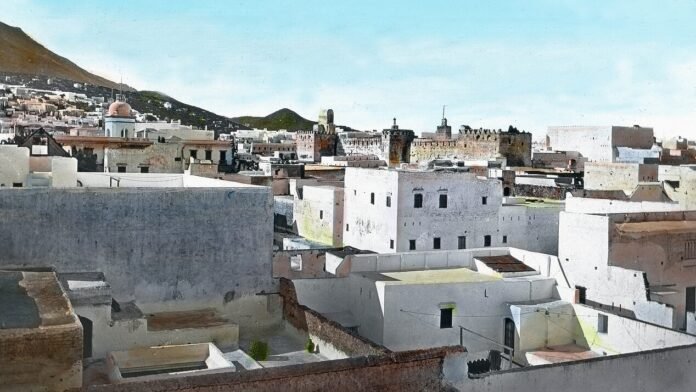Introduction
As an avid traveler, I always seek destinations off the well-trodden path that can offer a rich cultural experience. When planning my next trip to Morocco earlier this year, the coastal city of Tétouan immediately caught my eye for its artistic heritage and UNESCO World Heritage status. Located just 40 miles east of Tangier in northern Morocco, Tétouan seemed the perfect place to immerse myself in Moroccan culture away from the tourist crowds. I was not disappointed by what I discovered.
Tétouan presents itself as a veritable tapestry woven from the diverse cultural influences that have shaped its history and development over the centuries. Its architectural treasures, handicraft traditions, and lively medina offer a visual feast, while the warmth and hospitality of its people make it an engaging and memorable place to spend time. In this post, I hope to share more about Tétouan’s richness as an artistic center and cultural crossroads showcasing the intermingling of Andalusian, Moroccan, and Mediterranean identities it proudly upholds today.
A Cultural Crossroads Along Ancient Trade Routes
To understand Tétouan’s artistic splendor, we must first take a step back to appreciate its strategic location and the diverse peoples who have passed through the region across the centuries. Situated along the ancient trade routes between North Africa, Southern Europe, and the Middle East, Tétouan has long been a critical commercial outpost linking these different cultural spheres.
The city traces its origins to the Phoenicians, who founded a trading post in the area in approximately 1000 BC to facilitate exchanges along the Barbary coast. Over the following millennia, Carthaginians, Romans, Vandals, and Byzantines all controlled Tétouan intermittently, leaving their architectural imprint. However, it was under Muslim rule from the 8th century onwards that Tétouan became a thriving cultural and commercial hub.
Following the fall of Seville to the Christians in 1248, many Andalusians who were either expelled or fled religious persecution settled in Tétouan. They brought Moorish Spain’s refined artistic and architectural styles, leaving a profound and indelible mark visible today. Tétouan’s medina, whitewashed homes, intricate zellij tilework, and carved wood ceilings all reveal this Andalusian influence that blended harmoniously with local traditions. As Morocco established control over the region in the 15th century, Tétouan also came to take on distinctly Moroccan characteristics.
Meanwhile, throughout the early modern period, European powers like the Portuguese, Spanish, Dutch, and English vied to control North West Africa’s strategic ports. Though Tangier was the main prize, Tétouan, too, found itself subject to periodic occupations and power plays. By the late 18th century, however, Sultan Sidi Muhammad had secured Tétouan firmly as part of an independent Morocco.
Tétouan’s multilayered history as a cultural crossroads along prominent trade routes helps explain the richness and diversity of its artistic expressions today. Its architecture, arts, and crafts eloquently attest to this tapestry woven from Andalusian, Moroccan, and Mediterranean influences across the centuries. Let’s delve deeper into some of Tétouan’s crowning cultural treasures that earned it UNESCO World Heritage status rightfully.
The Architectural Splendor of the Medina
At the heart of Tétouan’s cultural significance lies its well-preserved medina, which UNESCO listed as exemplifying the syncretic urban fabric developed under Muslim rule in Northwest Africa. Wandering through its maze of narrow alleys is like stepping back in time, transported by the medina’s harmonious blend of architectural styles.
The most striking element is undoubtedly the whitewashed exteriors of homes and public buildings, an aesthetic influenced by Andalusian heritage. The vivid visual effect is striking and soothing to the eyes, brightening the passages between high walls. Interiors are no less ornate, with carved cedar wood ceilings, zellij tiling, arched windows, and intricate plasterwork decoration reflecting Andalusia’s Islamic legacy.
Public monuments within the medina attest to Tétouan’s heritage as a cultural crossroads. The grand Andalusian-style Ben Salama Mosque, dating to the 15th century, dominates one corner, its minaret still calling the faithful to prayer five times daily. Nearby, the small but exquisite Asuqriya School of Qur’anic Studies flaunts carved wood and ornate stucco typical of Moroccan tradition. Wandering further brings the traveler to Christian churches established when the city was under Spanish jurisdiction, including the Church of the Immaculate Conception, which remains in use today.
Tétouan’s medina also boasts some of the finest examples of Moroccan domestic architecture outside the imperial cities, with riads (courtyard homes) and fundus (inns) preserving their beauty through careful restoration. One such treasure is the beautifully restored Dar El Makhzen, once the sultan’s residence, with its colonnaded courtyard, fountain, and carved cedar ceilings magnificently restored to their former glory.
With strict rules against cars within the medina preserving its character, getting lost in Tétouan’s whitewashed alleys is like being gently transported across the centuries. It is easy to understand why this “living museum” was deemed worthy of UNESCO protection for representing an early North West African city displaying continuity and diversity in its urban form and architecture across the centuries.

Traditional Craftsmanship: From Leather to Pottery
Just as distinctive as Tétouan’s architecture is the wealth of handicraft traditions nurtured here over the years. Walking through the medina’s narrow lanes, one is struck by vibrant displays of locally produced goods at every turn. Though Morocco has gained fame for its arts and crafts, several uniquely Tétouani styles have evolved under the auspices of specialized guilds who have passed their techniques down through generations.
Foremost among these is the art of leatherwork, for which Tétouan has long been renowned. Local masters meticulously craft fine leather goods like slippers, bags, belts, and accessories primarily from sheepskin, using traditional wood-block stamping techniques to adorn them with geometric and floral patterns. The subtle blending of vibrant colors produces works of finely wrought beauty recognizably Tétouani in motif and sophistication.
Another renowned craft is pottery, where a distinct local folk style emerged influenced by the raw red clay abundant in the Rif mountains surrounding Tetouan. Vibrantly hued earthenware bearing simple plant motifs, incised patterning, and lustrous glaze are thrown, shaped, and fired using ancestral methods. Pottery making is still practiced at several local cooperatives, where visitors can watch the creation process.
Woodworking also thrives in Tétouan, prized for producing intricately carved decorative elements from cedar, olive, and other local hardwoods. Fine examples grace traditional riad homes throughout the medina and religious structures, imparting an aura of understated refinement. Meanwhile, specialized carpet weaving has developed distinctive geometric styles using wool and cotton in vibrant color combinations.
Wandering Tétouan’s souks and craft squares, one encounters a palpable pride and care in sustaining such heritage skills that distinguish the city and provide livelihoods. Master artisans readily welcome workshop visitors, happy to share expertise accumulated over generations. With the rise of machine manufacturing elsewhere, Tétouan’s commitment to nurturing artisanal traditions for future generations is admirable.
Cuisine: A Medley of Mediterranean and Moroccan Flavors
Another cultural aspect that adds to Tétouan’s richness is its distinctive local Moroccan-Mediterranean cuisine, shaped by the historically diverse influences that have converged here. Exquisitely prepared tagines, couscous dishes, and traditional sweets showcase culinary connections to Morocco’s imperial kitchens yet bear some flavors.
Seafood features prominently given Tétouan’s coastal location, from grilled sardines to calamari slow simmered in a herbs-infused sauce. Hearty stews might include chicken or lamb simmered with peppers, preserved lemon, green olives, and capers – influences reflecting ties to the neighboring Mediterranean.
For sweet-toothed travelers, Tétouan boasts its specialty called “shares” – shortbread cookies fragrantly spiced with aniseed and nuts that may betray a shared recipe legacy between Morocco and Spain. “Cornes de gazelle,” crescent-shaped pastry treats stuffed with almond paste, further fuse Moroccan tradition with hints of Europe.
Cafes and home-style diners throughout the medina showcase such delights, often including traditional mint tea poured from gleaming copper pots to punctuate the meal. Dining is as much a cultural experience as enjoying good food, as clientele lingers for hours of conversation over shared plates at low tables.
FAQs
Q: What architectural styles can be seen in Tétouan?
A: Tétouan’s architecture blends Andalusian influences introduced by refugees from Spain with traditional Moroccan styles. Notable features include whitewashed exteriors, carved wood ceilings, zellij tilework, arched windows, and intricate plasterwork that adorn riads, fundus, mosques, and other buildings. The Ben Salama Mosque and Asuqriya School exemplify the city’s Andalusian and Moroccan influences.
Q: What crafts is Tétouan known for?
A: Famed crafts produced in Tétouan include finely stamped leatherwork, pottery bearing traditional designs, and ornately carved woodwork. Local masters meticulously produce leather slippers, bags, and accessories using traditional techniques passed down through generations. The city also has a distinctive folk pottery style employing lustrous glazes and incising.
Q: What is there to do in the medina?
A: Wander the maze of whitewashed alleys, taking in the architectural treasures, craft shops, and galleries. Admire restored riads like Dar El Makhzen. Shop for locally made goods in the souks. Pause for mint tea and cuisine like tajines in the cafes and restaurants. Absorbing the laidback ambiance is as much an attraction as the cultural heritage on display.
Q: Are any activities available outside the medina?
A: Though the medina is a top attraction, Tétouan’s environs offer scenic hiking trails along the Mediterranean coast among olive and almond groves. For panoramic city views, climb to the Spanish Mosque on a hill above the medina. Beaches a short drive away are famous for swimming and water sports in summer. The outskirts also include the ethnographic Ribat Museum, which illuminates Tétouan’s cultural history.
Q: What is the best time of year to visit?
A: Spring (March-May) and fall (September-November) have mild Mediterranean weather, ideal for exploring Tétouan’s attractions comfortably. Summers are hot, but beaches beckon, while winters are mild with occasional light rain. Though some restaurants may have limited hours, Ramadan brings a lively cultural atmosphere.
Q: How should visitors respect local culture and customs?
A: Follow etiquette like dressing modestly, especially in mosques. Remove shoes before entering homes or riads. Learn basic Arabic greetings and be polite yet discreet when interacting with locals. Ask permission before photographing people. Respect that Friday is a day of prayer when shops may close briefly. Tipping for good service is appreciated.
Conclusion
Tétouan offers a rich cultural experience for those seeking to immerse themselves in Morocco’s heritage beyond the typical tourist destinations. Its medina’s labyrinthine streets and eclectic architecture are a visual feast while welcoming residents ensure the city buzzes with life. With its artistic traditions carefully nurtured through the generations, Tétouan has become a treasure trove of Andalusian-Moroccan syncretism deserving of its UNESCO status. For travelers fascinated by Moorish influences and handicrafts, this Mediterranean gem rewards taking the time to absorb its charming atmosphere and tapestry of history on display.

